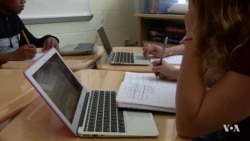ຄໍາເວົ້າວ່າ “ຂ່າວບໍ່ມີມູນຄວາມຈິງ” ໄດ້ຍິນມາຢ່າງຫຼວງຫຼາຍໃນທຸກວັນນີ້ ໂດຍສະ
ເພາະແມ່ນຈາກ ປະທານາທິບໍດີດໍໂນລ ທຣໍາ, ຈາກພວກນັການເມືອງ, ນັກຂ່າວ ແລະຈາກຂຽນລົງຢູ່ໃນເວທີສື່ສັງຄົມອອນລາຍເຊັ່ນທວີດເຕີນັ້ນອີກ. ພວກນັກຮຽນ
ມັດທະຍົມຈຳນວນນຶ່ງຢູ່ໃນສະຫະລັດ ແລະຢູ່ທົ່ວໂລກພາກັນສາມາດເຂົ້າໃຈດີກ່ຽວ
ກັບຂ່າວທີ່ບໍ່ມີຄວາມຈິງ ແລະຂ່າວມີຄວາມຈິງໄດ້ດີຂຶ້ນ ໂດຍການຮຽນເອົາຄວາມຮູ້
ໃນການອ່ານຂ່າວຢູ່ໃນຫ້ອງຮຽນ. ນັກຂ່າວ ວີໂອເອ ເດບຣາ ບລ້ອກ ນຳພາພວກ
ເຮົາໄປທີ່ມັດທະຍົມແຫ່ງນຶ່ງໃນເມືອງອາລິງຕັນ ລັດເວີເຈີເນຍ ຊຶ່ງກິ່ງສະຫວັນ ຈະ
ນຳມາສະເໜີທ່ານໃນອັນດັບຕໍ່ໄປ.
ຢູ່ມັດທະຍົມເວກຟຽວລ໌ (Wakefield) ແຫ່ງນີ້ ທີ່ຢູ່ໃນເມືອງອາລິງຕັນ ລັດເວີຈີເນຍ
|ພວກນັກຮຽນມັດທະຍົມປາຍ (ຫ້ອງ 12) ພາກັນຮຽນຮູ້ວິທີເບິ່ງວ່າ ອັນໃດເປັນຂ່າວ
ສານທີ່ບໍ່ມີມູນຄວາມຈິງ ຫຼື ເປັນການໃຫ້ຂໍ້ມູນທີ່ຜິດ.
ຍານາງປາຕຣີເຊຍ ຮັນຕ໌ ນາຍຄູສອນກ່າວວ່າ “ການຄົນທີ່ຖືກຊວນໃຫ້ເຊື່ອ ໃນຂໍ້
ມູນທີ່ຜິດນັ້ນ ເປັນເລື້ອງໃຫຍ່ຊໍ່າໃດ?”
ຍານາງປາຕຣີເຊຍ ຮັນ ນາຍຄູສອນສັງຄົມວິທະຍາ ໄດ້ໃຊ້ຫລັກສູດການສອນ ໂດຍ
|ຜ່ານທາງດີຈິຕອລ ທີ່ເອີ້ນວ່າ Checkology ຫຼືວິທີການກວດເບິ່ງຂ່າວ ເພື່ອໃຫ້ພວກ
|ນັກຮຽນເຫັນໂຕຢ່າງແທ້ຂອງຂ່າວ ຢູ່ໃນໂລກຕົວຈິງ ແລະຂໍ້ມູນຕ່າງໆທີ່ມີມູນຄວາມ
ຈິງ, ຫລືໃຫ້ຂໍ້ມູນທີ່ຜິດ ຫຼືເປັນການຂີ້ຕົວະຢ່າງ ເປີດແປນ.
ເອົາໂຕຢ່າງເຫດການຍິງທີ່ເກີດຂຶ້ນເດືອນກຸມພາ ຢູ່ທີ່ມັດທະຍົມແຫ່ງນຶ່ງໃນເມືອງພາກ
ແລນ, ລັດຟລໍຣິດາ ທີ່ມີນັກຮຽນ 14 ຄົນ ແລະນາຍຄູສາມຄົນໄດ້ຖືກຂ້າຕາຍ. ຍານາງບອກພວກນັກຮຽນໃຫ້ພາກັນຄິດດບິ່ງດຸວ່າ ຂ່າວຊາລືກັນທີ່ໄດ້ປ່າວປີວອອກມາ ພາຍ
ຫຼັງທີ່ມີການຍິງກັນເກີດຂຶ້ນແລ້ວນັ້ນ ທີ່ຈິງແລ້ວ ມັນ ມີີມູນຄວາມຈິງຫຼືບໍ່.
ຍານາງປາຕຣິເຊຍ ກ່າວວ່າ “ພວກນັກຮຽນພາກັນໄດ້ຮັບຂໍ້ມູນຢ່າງຫຼວງຫຼາຍ ແລະ
ພວກເຂົາກໍຍັງໄດ້ຮັບອັນທີ່ເອີ້ນກັນວ່າຂ່າວ, ຂ່າວຂີ້ຕົວະ, ຄຳຊາລືທີ່ ປ່າວປີວ ແລະ
ຂໍ້ມູນທີ່ຊວນເຊື່ອຂ່າວຢ່າງຫຼວງຫຼາຍ ພາຍມາກ. ຄວາມມຫວັງ ໃນການສອນບົດ
ຮຽນຂອງຂ້າພະເຈົ້າກໍຄື ພວກເຂົາ ຈະສາມາດບອກໄດ້ວ່າ ອັນໃດຄືການອອກຂ່າວ
ທີ່ມີຄຸນນະພາບ ເມື່ອພວກເຂົາເຈົ້າໄດ້ເຫັນມັນແລະ ພວກເຂົາເຈົ້າກໍຈະສາມາດ
ບອກໄດ້ວ່າອັນໃດຄືການໂຄສະນາຊວນເຊື່ອທີ່ ບໍ່ທ່ຽງທໍາ, ບໍ່ກໍ້າເກິ່ງ, ບໍ່ມີມູນຄວາມ
ຈິງ ແລະອັນອື່ນໆ ເຊັ່ນກັນໃນເວລາທີ່ ພວກເຂົາເຈົ້າເຫັນ.”
ການສຶກສາຄົ້ນຄວ້າສະແດງໃຫ້ເຫັນວ່າ ພວກໄວໜຸ່ມ ພາກັນໄດ້ຮັບຂໍ້ມູນໃຫຍ່ມາຈາກ
ສື່ສັງຄົມ.ແລະພວກເຂົາກໍມັກຈະເຊື່ອຂໍ້ມູນທີ່ໄດ້ມາຈາກພວກໝູ່ເພື່ອນຂອງຕົນ.
ທ່ານອາແລັນ ມິລເລີ (Allen Miller), ຜູ້ສ້າງຕັ້ງໂຄງການສຶກສາຂ່າວ ທີ່ເປັນອົງການ
ບໍ່ຫວັງຜົນກໍາໄລຂຶ້ນ ຊຶ່ງຮວມທັງ Checkology ຫຼືວິທີການກວດເບິ່ງຂ່າວ.
ທ່ານມີລເລີ ກ່າວວ່າ “ຂ້າພະເຈົ້າຕື່ນຕົກໃຈແທ້ໆ ທີ່ເຫັນວ່າພວກນັກຮຽນ ຂ້ອນ
ຂ້າງວ່າຈະເຫັນຂໍ້ມູນທັງໝົດທີ່ມີຢູ່ນັ້ນມີຄວາມເທົ່າທຽມກັນ. ຖ້າຫາກ ເຂົ້າເຈົ້າຍັງ
ນ້ອນກວ່ານີ້ ເຂົາເຈົ້າກໍອາດຈະຄິດໂລດວ່າ ຖ້າມີຜູ້ໃດຜູ້ນຶ່ງ ນຳເອົາຂໍ້ມູນໄປໃສ່
ຢູ່ໃນອິນເຕີແນັດກໍໝາຍຄວາມວ່າ ຄົນນັ້ນໄດ້ກວດກາ ຄວາມຖືກຕ້ອງແລ້ວ ແລະ ກໍເປັນຄວາມຈິງທັງໝົດ. ເຂົາເຈົ້າມີທ່່າອ່ຽງວ່າ ຈະເຊື່ອ ແລະກໍນຳເອົາໄປບອກ
ໃຫ້ກັນຮູ້ຕໍ່. ເມື່ອເຂົາເຈົ້າເຂົ້າຢູ່່ມັດທະຍົມ ປາຍ ເຂົາເຈົ້າເລີ້ມຈະບໍ່ເຊື່ອຫຼາຍຂຶ້ນ ແລະເຂົາເຈົ້າອາດຮູ້ສຶກວ່າ ທຸກຂ່າວລ້ວນແຕ່ ຖືກຜັກດັນດ້ວຍຄວາມລໍາອຽງ ແລະ
ເພື່ອຈຸດປະສົງເຊື່ອງຊ້ອນຢູ່. ອັນທີ່ເຂົາເຈົ້າ ຂາດນັ້ນກໍຄືຄວາມຊຳນິ ຊຳນານໃນ
ການໃຊ້ຄວາມຄິດແບບພິນິດ ພິຈາລະນາ ຢ່າງຖີ່ຖ້ວນເພື່ອຈະຮູ້ໄດ້ວ່າ ຈະເຮັດ
ຈັ່ງໃດກັບຂໍ້ມູນທັງໝົດເຫລົ່ານັ້ນ.”
ນັກຮຽນຜູ້ນີ້ມີແຜນທີ່ຈະເບິ່ງສື່ສັງຄົມອອນລາຍດ້້ວຍສາຍຕາທີ່ພິນິດ ພິຈາລະນາ
ຢ່າງຖີ່ຖ້ວນ.
ນາງອາມໍຣີ ແກຣນທ໌ (Amory Grant) ນັກຮຽນມັດທະຍົມປາຍເວັກຟຽວລ໌ ກ່າວວ່າ
“ບັດນີ້ ຂ້ອຍສາມາດທີ່ຈະຮູ້ວ່າ ຈະກວດເບິ່ງໄດ້ວ່າ ອັນໃດຄືຂໍ້ມູນທີ່ ແທ້, ອັນໃດ
ຕົວະ, ແລະຄວນຈະຊອກເບິ່ງອັນໃດຈຶ່ງຈະຮູ້.”
ທ່ານອາແລັນ ມິລເລີ ບອກວ່າ “ອັນທີ່ພວກເຮົາຢາກໃຫ້ນັກຮຽນໄດ້ຮຽນຮູ້ກໍຄື ຄວາມສາມາດທີ່ຈະຊັ່ງຊາເບິ່ງຄວາມໜ້າເຊື່ອຖືຂອງຂ່າວທຸກອັນ ແລະຂໍ້ມູນ ຕ່າງໆທີ່ເຂົາເຈົ້າໄດ້ພົບ.”
ແລະມັນກໍປາກົດວ່າກຳລັງໄດ້ຜົນດີຢູ່.
ທ້າວຊີຮິນ ຍິບບຣາ (Sihin Yibrah), ນັກຮຽນຢູ່ມັດທະຍົມປາຍເວັກຟຽວລ໌ ກ່າວວ່າ “ຂ້າພະເຈົ້າໄດ້ຮຽນໃນການກວດເບິ່ງຂໍ້ມູນຄວາມຈິງແລະວີທີໃນ ການຊອກເບິ່ງ
ຂ່າວທີ່ບໍ່ມີມູນຄວາມຈິງໂດຍການອ່ານຫົວຂໍ້ຂ່າວ ແລະ ກວດເບິ່ງວ່າ ມີຊື່ຂອງຜູ້
ພິມເຜີຍແຜ່ຂ່າວນັ້ນຫຼືບໍ່.”
ທ້າວແຄບວິນ ຟລໍຣິມອນ ນັກຮຽນມັດທະຍົມປາຍເວັກຟຽວລ໌ ເຊັ່ນກັນ ກໍເວົ້າ ວ່າ
“ຂ້າພະເຈົ້າ ຄິດວ່າຈະສາມາດກວດເບິ່ງຂ່າວຫລາຍໆອັນໄດ້ດີຂຶ້ນ ແລະກໍໝັ້ນ
ໃຈໄດ້ຫຼາຍຂຶ້ນຍ້ອນໄດ້ຮູ້ວ່າຕົນເອງຈະບໍ່ໄດ້ຖືກຫຼອກ ໃຫ້ເຊື່ອໄດ້ຢ່າງງ່າຍໆ.”
ພວກນາຍຄູຫຼາຍພັນຄົນໄດ້ພາກັນໃຊ້ຫລັກສູດສອນ Checkology ຫຼືວິທີການ
ກວດເບິ່ງຂ່າວແບບດີຈີຕອລ ຢູ່ໃນສະຫະລັດ ແລະຢູ່ 90 ປະເທດອື່ນອີກ ເພື່ອ
ຊ່ວຍໃຫ້ພວກນັກຮຽນຊອກຮູ້ຄຸນນະພາບຂອງຂ່າວຕ່າງໆ ດ້ວຍຕົນເອງ.
ປະທານາທິທິບໍດີທຣໍາ ກ່າວວ່າ “ຂ່າວຂີ້ຕົວະ.”
ສິ່ງທີ່ພວກເຂົາເຈົ້າໄດ້ຍິນ ຫຼືໄດ້ເຫັນນັ້ນມີຄວາມຈິງ ຫຼືບໍ່.
[[The term fake news" is heard a lot these days, especially from President Trump, other politicians, journalists and also posted on social media platforms like Twitter. Some high school students in the United States and around the world are getting a better understanding of fake and real news by learning literacy media skills in the classroom. VOA's Deborah Block takes us to a high school in Arlington, Virginia.]]
Here at Wakefield High School in Arlington, Virginia, these seniors (12th graders) are learning to identify false or misleading information.
Teacher Patricia Hunt—"What's the big deal about people being misinformed?"))
Social studies teacher Patricia Hunt is using a digital course called Checkology to give students real world examples of news and information that is either factual, misleading or just plain false.
Take February's high school shooting in Parkland, Florida, where 14 students and three teachers were killed. She asks the students to think about whether the rumors that swirled after the shooting were actually real.
"Students are bombarded with information, and they are also bombarded with so-called news, fake news, viral rumors and misinformation. My hope in my lessons is that they will be able to identify quality journalism when they see it, and they'll be able to identify unfair, unbalanced, fake, propaganda and the like when they see it too."
Studies have shown that teens get most of their information from social media. And they are more likely to believe the information they get from their friends.
Alan Miller is the founder of the non-profit News Literacy Project, which includes Checkology.
"I've really been struck by how students tend to see all information as created equal. If they're younger, they may think that if somebody put it on the Internet they've verified it and it's all true. They're inclined to believe it and share it. By the time they're in high school they're more cynical and they may feel that it's all equally driven by bias, by agenda. What's missing is that critical thinking skills to know what to do with all of that information."
This student plans to look at social media with a more critical eye.
"Now I know how to decipher what's real, and what's fake, and what to look for."
"What we want the students to take away is the ability to assess the credibility of all news and information they encounter."
And it seems to be working.
"I learned about fact checking and ways to find false news by headlines, and seeing if there are publishers."
"I think I will be able to go through news a lot better, and rest easier, knowing that I'm not going to be tricked as easily."
Thousands of educators are using the digital Checkology course in the U.S. and in other 90 countries, helping students recognize for themselves….
...if what they are hearing or seeing is true or not.





